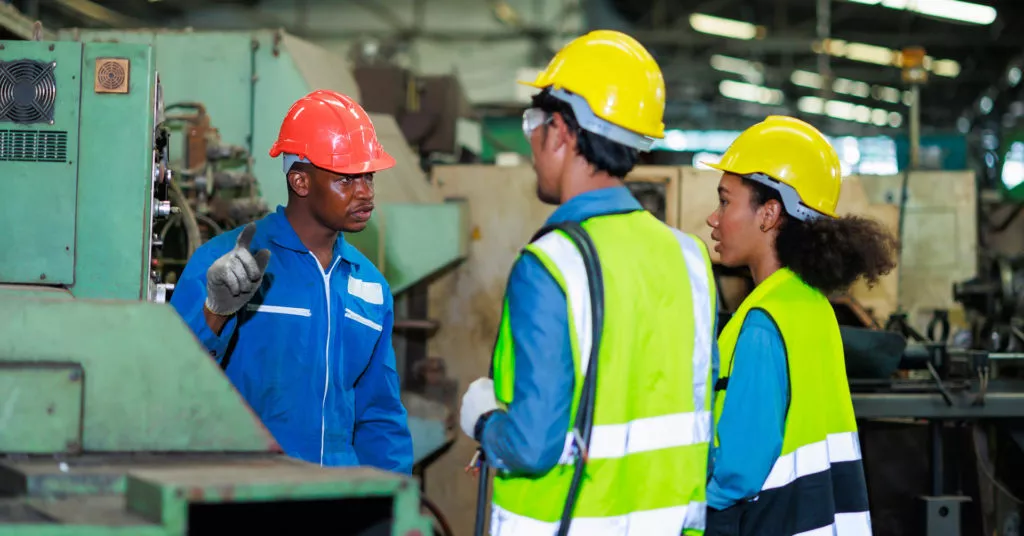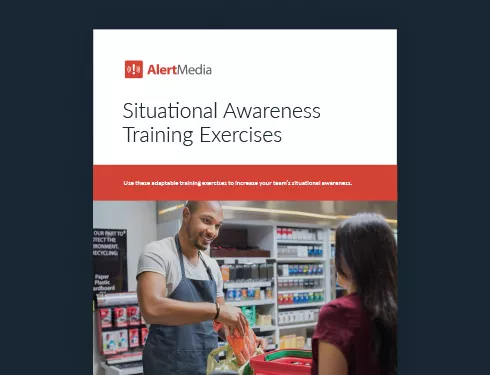
Situational Awareness Training Promotes Workplace Safety
Situational awareness training is a great way to promote better safety practices at any work site. Keep reading to learn how to keep your employees out of harm and your business operating smoothly.

When was the last time you felt that prickle in the back of your mind? That gut feeling that something was wrong or that something might happen?
Maybe you could sense that your kitchen was warmer than usual, so you went to see if the oven was left on. Maybe you saw a cup placed very close to the edge of a table, and you moved it toward the middle to prevent it from getting knocked over. These are all examples of situational awareness, at least on a small scale.
But how does this manifest at work?
Maybe you work in retail and notice strange body language from a customer, so you wait by the doors to see if the detectors go off when that person leaves. Or maybe you work in manufacturing and notice a pile of sawdust has collected under a hot saw that is throwing off sparks, so you clean it up before a fire can start.
That sense of awareness—and the understanding of what to do when you get a gut feeling about something dangerous—is not something that comes naturally. These are skills that need to be trained. In fact, all employees need situational awareness training to help prevent accidents and dangerous events.
“You have to start with training. It all starts with people on the ground level because those people are the backbone for making every security process work correctly.” — Shawn Rafferty, Owner of SPR Group
By giving your frontline workers tools to notice and stop potential threats, you can increase the overall safety of your worksite. This article will show how to promote workplace safety with situational awareness and how to build your training program.
What Is Situational Awareness?
Situational awareness is the practice of actively monitoring your surroundings in order to spot potential hazards or risks—so you can quickly act to stop any escalation and mitigate harm.
By training for situational awareness in the workplace, you set your employees up to be more observant on the job, ready to anticipate potential threats and respond effectively for safer outcomes.
How Situational Awareness Training Boosts Workplace Safety
There are many options of safety trainings you could be integrating into your safety program—situational awareness is unique in that it can apply to any and all emergency situations. While training for a fire drill is an important and life-saving skill that ensures your people know how to evacuate safely, the practice is limited to a specific emergency situation. Beyond drills that help employees prepare for unique situations, a wider-reaching goal is to build transferable skills.
Situational awareness training supports generalized skill building. It can help promote safe actions in any environment and during any kind of crisis. The mental tools used to observe your surroundings and assess what might be wrong can work for something as simple as speeding up a process and something as complicated and high-stakes as an active shooter situation.
When your employees are armed with broadly applicable observation, assessment, and interpretation skills, they are also going to feel more confident and prepared. Readiness can go a long way toward avoiding confusion and panic, especially when things go sideways. Employees will be ready to act without hesitation to protect themselves and others—protecting the business in the process.
Fear vs. awareness
It’s important to make a clear distinction between situational awareness and fear-based reaction. You don’t want to create an environment where employees are constantly on their toes or are scared of what will happen at work. This could result in more accidents than prevention because your employees are reacting rather than observing.
For example, in the case of active shooters, you don’t want your employees to be afraid of anyone entering the building in all black or wearing a backpack. That’s not situational awareness; that is fear. Instead, train your team to recognize suspicious body language.
The goal of situational awareness is to promote a safe work environment, but being constantly on edge and afraid is not safe. So be sure to emphasize the importance of situational awareness from a calm and collected mindset. And remind employees that having training in situational awareness means they are less likely to be caught off guard by a threat.
“There are employees who are legitimately concerned about their safety when they leave their house every day and everywhere in between. And if an employee were to come into work and have those concerns while in the workplace, clearly, that’s going to affect them and their ability to do what they’re expected to do on a daily basis.” —Andrew “Drew” Schrader, Head of Corporate Security at Panasonic North America
How to Create a Situational Awareness Training Program
When you’re ready to build out your situational awareness training program, you don’t want to just assign an online training course and expect that to be enough. Good situational awareness takes practice and repetition in order to become second nature.
Here are some tips to build out a training program that will actually work for all your team members.
1. Set expectations
The best way to ensure success in your situational awareness training is to set expectations about what will happen. Your employees should know what the training will entail and what will be expected of them in each session and throughout the program. When they understand the objectives, they will be more likely to engage with the exercises and improve their skills.
Your leadership team should also understand what the process will ask of the business. These training programs take time and money, and getting leadership buy-in is make or break. Be very clear about what the training will look like and what you expect to gain from it so you are setting yourself up for continued support.
2. Build consistency
You’re going to see the most success with your training when you are consistent. Your employees need regular practice in these skills to build the habit of being aware, so one single half-hour session isn’t going to cut it.
Consider adding a short situational awareness training exercise to monthly safety meetings. Or schedule longer quarterly trainings where you go through multiple activities. The goal is to keep these skills top of mind and create a higher baseline level of awareness for your employees through practice.
3. Adapt as necessary
Like with any other health and safety training, there is no one-size-fits-all approach to situational and risk awareness training. Don’t be afraid to personalize pre-built training courses and exercises since they are likely pretty broadly designed to apply to any business or situation. You want your employees to be able to spot and respond to the dangerous situations they will face at your specific site.
A great way to personalize your training exercises is to use situations that your business has already faced. Go through your historical events and pick out incidents with clear (or even unclear) warning signs that can serve as examples in training. You can customize tabletop exercise templates to create engaging practice scenarios for your employees to navigate and troubleshoot together.
Then work to adapt your training to better fit your employees. You may have remote workers who cannot attend regular in-person trainings. Or you may have some employees who need more training than others. Make sure you are using or building a program that can support employees with different roles and limitations, and train to the lowest common denominator so all your employees have the same base level of understanding.
“What I see oftentimes is that the security people get training, but the frontline people, the people who have interactions, associates, salespeople, field-based personnel, who deal with customers, clients, and even interact with the public, don’t get the training. Oftentimes they’re the ones that are potentially most at risk. They’re the ones that are going to see anomalous behavior and they need training to recognize what’s appropriate, what’s anomalous, and how to go about reporting it.” —Bill Flynn, Co-founder and Chief Strategy Officer at The Power of Preparedness
What Does Situational Awareness Training Look Like?
There are different frameworks, exercises, and training options you can use to build situational awareness for your team. There are also free online resources you can lean on. Here are a few examples and some guidelines on how to use them.
Situational awareness frameworks
These frameworks are great ways to make situational awareness more approachable. They break down the skills into something a lot easier to understand and more applicable in the real world.
When building your training program, pick a framework that works well for your specific situation, or use all three at different times.
The SLAM technique
The SLAM technique breaks down the process of awareness into four steps:
- Stop — Pause what you are doing
- Look — Observe the environment for potential risks or hazards
- Assess — Assess and analyze the hazard
- Manage — Take care of the situation by removing/fixing the hazard or stopping the task
When training for this technique, teach your employees to follow these steps before any new task.
The SLAM technique in action:
Your team is starting the day on a construction site after a major storm overnight. Before beginning work, you’ve trained them to use the SLAM technique. So they stop and look, and notice that a tree has a branch that is very close to falling right above where they are planning to work. They assess the tree branch and see it would be safer to cut the branch before. So they manage the hazard and proceed, preventing a potential accident.
The OODA loop
Much like the SLAM technique, the OODA loop is a framework for safe decision-making based on the observed situation. Here are the four steps:
- Observe — Look around and see what is happening
- Orient — Put all of the information in context
- Decide — Make your decision based on the information and context
- Act — Perform the identified task or action
This is a great exercise to train your employees to use during high-risk situations as well as everyday operations.
The OODA loop in action:
The fire alarm goes off in your building. You’ve trained your employees to use the OODA loop in situations where they are unsure about a situation. A group of evacuees has reached a closed doorway. They observe the doorway and see smoke seeping through the cracks, and they touch the door handle, and it feels hot. They orient themselves and know there is another evacuation route nearby. So they decide to go the other way and act on that decision, getting out safely.
The four levels of situational awareness
This situational awareness framework was built for personal safety and awareness, but it can be just as effective in workplace situations. This framework uses colors to represent four levels of situational awareness that categorize how aware you are.
- Condition white — This code means you are completely unaware, not paying attention to your surroundings.
- Condition yellow — This code means you are relaxed, but still aware of what’s going on. There is no apparent potential threat, but you would notice if one appeared.
- Condition orange — This code means you have a heightened sense of awareness. Maybe there is a potential threat nearby, and you begin to think about your response.
- Condition red — This code means you are having to act on a threat. There is imminent danger, and you must respond.
You can train your employees to use these color codes to report on their status. You can also assign codes as context during events, clueing employees into the appropriate level of awareness.
“In the end, our goal is to make sure that the employees leave the day the same way they came in. We don’t want to have any sort of atmosphere in our facilities that makes them think about anything other than the task at hand. No employee should ever go to work worrying about outside factors influencing them, especially those regarding violence.” —Andrew “Drew” Schrader, Head of Corporate Security at Panasonic North America
Situational awareness exercises
Here are some exercises you can use in your situational awareness training that will help build the necessary skills, including observation, retention, assessment, and reporting.
These exercises can be used over and over again, and they should be a regular part of your situational awareness training. You can download free templates for all of these exercises here to customize and use in your training program.
Kim’s Game
Kim’s game (named after a spy character from a Rudyard Kipling novel) is an exercise focused on training your memory. You show employees a group of items and challenge them to list as many as they can without looking again. This training exercise is helpful for remembering things during an emergency, such as where critical tools or items are located. It is also a helpful practice to notice when there might be something abnormal in a space.
Mock scenario
Mock scenarios guide participants through an imagined dangerous situation in a safe environment, challenging their decision making. This exercise helps your team practice recognizing potential hazards and choosing a safe response.
Observational awareness exercise
This exercise tests observation skills by challenging the participants to describe details of a space without looking at it. With repetition, this exercise will train your employees to be more visually aware of what is going on around them so they will notice any suspicious items or people.
You can also use videos that test observational skills, like this one, if you have employees who cannot attend in-person training.
Safety briefing “exit interview” exercise
Performing an “exit interview” will train your employees to pay attention during an encounter by asking them detailed questions about a safety meeting they just attended. This will prepare them for remembering things like response plans, complex safety instructions, or key details from a conversation with a suspicious person.
Everyone’s Tool to Build a Safer Workplace
When you train your employees in situational awareness, you are giving them a set of tools that will not only help them keep themselves safe and keep your business operations running smoothly, but also make them feel more comfortable on the job every day.
Just like knowing how to use a fire extinguisher or learning self defense, these tools are meant to be there in case you need them. Everyone hopes that their work day will run smoothly with no dangerous interruptions, but having the training to recognize when something is wrong and how to respond will likely be the difference between a normal day and a catastrophe.





